 |
| Miguel Mackinlay, Still Life With Eggs, 1923 (Acknowledgement to the MJ McKinlay Trust) |
Do please pass me another egg, Mr P.
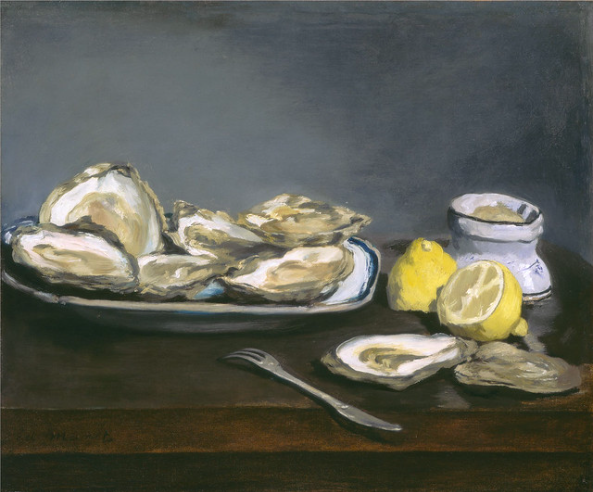 |
| Edouard Manet, Oysters, 1864 |
[Later ... ] Yes, the oysters are delicious!
 |
| Sarah Lamb, Bistecca ala Fiorentin, 2019 |
[Even later ... ] How would you like your chop, my dear?
... And there you basically have it, Dear Reader; nothing juicy yet to report on the new carnivorous régime about these parts. We're still alive and trundling along. Which all rather makes dull fodder for this blog's Something-to-Eat creed. Where are the thrilling anecdotes from the growing store of culinary adventures?, you may cry. Regretfully lacking at this juncture.
So, rather than continue with the monotonous litany of "oysters, eggs, chops, ... &c &c", which may only titillate the oh so curious, I shall instead, from time to time, steal some table talk from the literary world for these pages, such as may be found in Patrick White's marvellous 1981 memoir, Flaws in the Glass:
The kitchen stove, antique electric, had Queen Anne legs like so much of the furniture in the house. We had many cooking accidents before learning how: there was the day Rosemary Dobson Bolton brought her first baby to lunch and the oven in which I was grilling the baby's chop caught fire: the Christmas dinner during the heatwave when the pair of drakes (or swans) we had bought from Mrs Poulter bounced on the lino before I dished them up; there was the whole coq au vin I spilled on the floor, but mopped up, schnauzer hair and all, and served John Gielgud. Although I say it, that coq au vin was about the best I have tasted.*
Anyway, in other news, we went to the most excellent touring exhibition of Melbourne-born Art Deco printmakers, Ethel Spowers & Eveline Syme. As ever, the show has already moved on from Sydney, where it was held at the S. H. Ervin Gallery, but there is still opportunity to see it in Brisbane before the delicate prints get packed away again for some unknown more number of years in June. Spowers and Syme were friends and daring trailblazers of contemporary art and after studies in London's Grosvenor School with Claude Flight, embraced linoprinting to great effect.
 |
| Ethel Spowers woodcut, Melbourne from the River, c. 1924 |
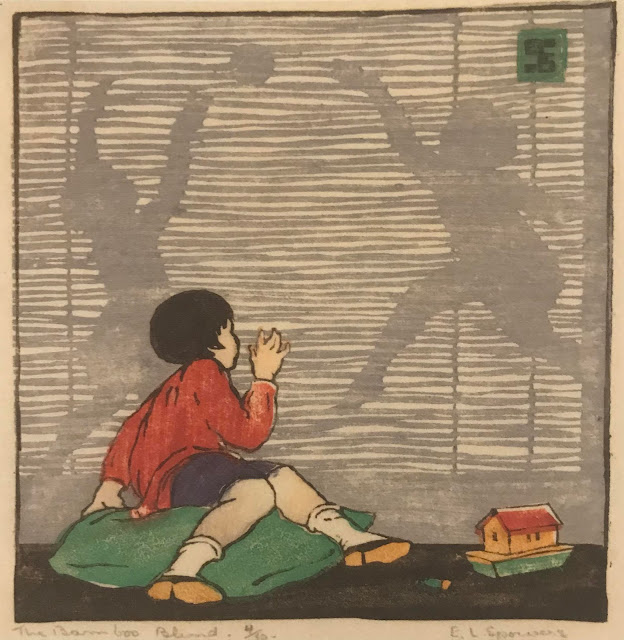 |
| Ethel Spowers linocut, The Bamboo Blind, 1926 |
Spowers had a particular affinity for imagery of childhood, writing and illustrating children's stories.
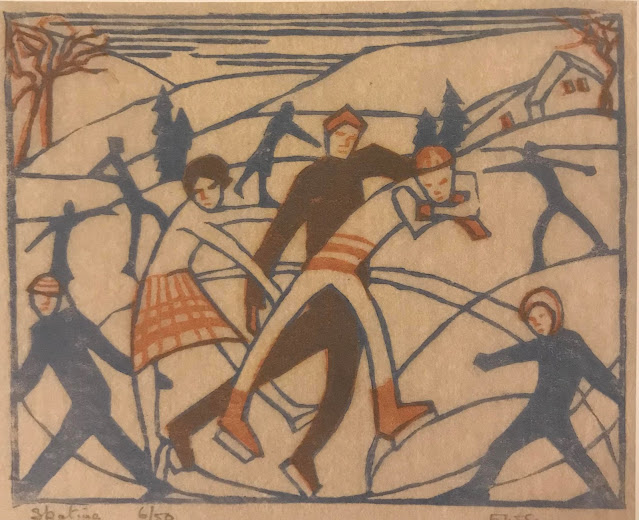 |
| Eveline Syme linocut, Skating, 1929 |
Both born into families of newspaper magnates, they were educated, independent and well-travelled. They both championed modern art and their work is instantly identifiable as of its time.
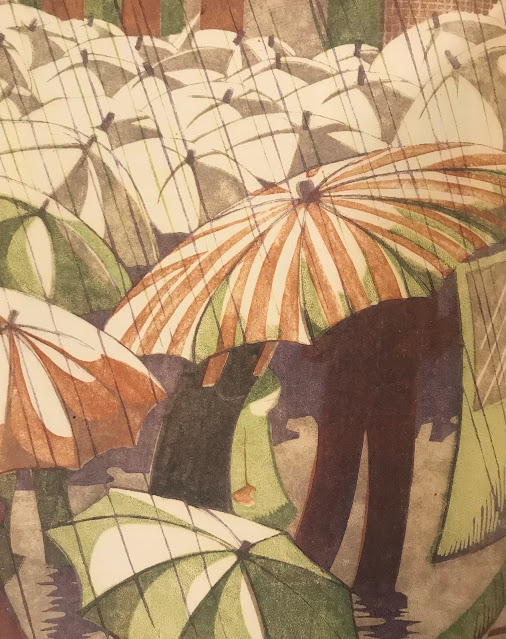 |
| Ethel Spowers linocut, Wet Afternoon, 1930 |
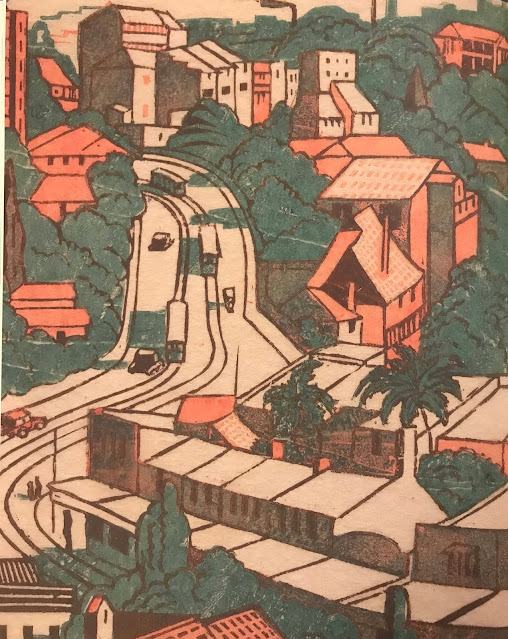 |
| Eveline Syme linocut, Sydney Tram Line, 1936 |
 |
| Ethel Spowers linocut, School is Out, 1936 |
The exhibition was a delight, not only to see their familiar images** but earlier works and the associated ephemera of the era, and linocuts by contemporaries who'd also fallen under the spell of the charismatic Flight. Fellow student Dorrit Black wrote of him: 'He is a very small man with very bright eyes, little bits of side-curls, and one feels instantly at one's ease with him. During the summer he lives in a cave in France, a very attractive cave, apparently, but still a cave; and in the winter he comes out of his cave to teach lino-cutting to students at the Grosvenor School.'
 |
| Nota bene: Not Claude Flight but a Lenci porcelain, Squirrel and Acorns, 1929 |
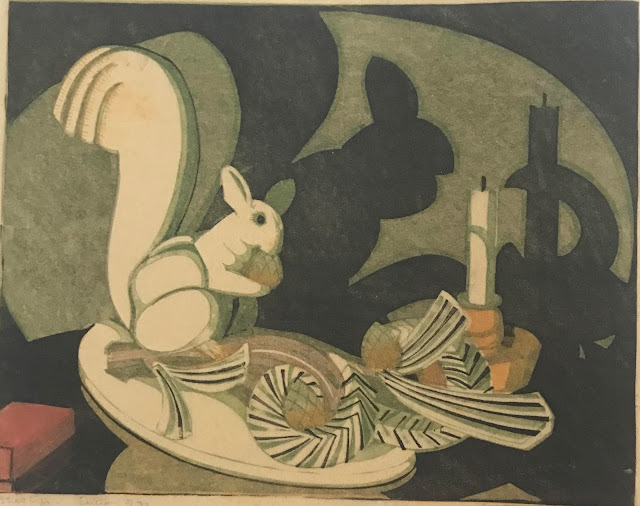 |
| Ethel Spowers linocut, Still Life, 1932 |
 |
| Sybil Andrews linocut, Speedway, 1934 |
In other news, the Musical Year has started for the Pipistrellos. Our beloved Utzon Series, the intimate recitals by visiting international stars, was a Casualty of Covid and looks not to be revived, but we got to sit in the gorgeous room again last week to hear the home-grown Australian Haydn Ensemble. A very pleasant change to the old routine is the ability to reserve seating when you book, and Mr P. nabbed front and centre seats, normally the domain of a gang of silver-haired Utzon Series stalwarts who'd stake this territory as an assumed right (and invariably fall promptly asleep after the complimentary tipple once the music started.)
Our repast consisted of a selection from Bach's The Art of Fugue; Haydn's String Quartet in A major (Sun Quartets); and Mendelssohn's String Quartet No. 2 in A minor Op. 13. Super delicious!
 |
| Lorna Singleton Oak Spelk Basket |
Finally, do you love a basket with which to collect your comestibles from the shoppes? There are baskets to be found herein about the casa, and their usefulness is fully appreciated, however I was surprised to learn that there is a type of basket make from oak! Well, oak splinters not logs, obv.
There is a mere slip of a girl living in the woodland in South Cumbria in England making a living from weaving these traditional baskets. Once a thriving craft, the resulting baskets were used for everything from charcoal scuttles on steam ships and trains to tatty and turnip baskets in the field to swilling cockles in the sea, whence comes the name oak swill baskets. There seems to be only a handful of weavers left, including the lissome Lorna Singleton.
Here's a tantalising 15-minute documentary film on her and her work: Oak Swill Basketry.
* The take-away here, of course, is not that Nobel Prize-winning writers nor those who rub shoulders with the glitterati at the tea table have the best lines, rather it's schnauzer-lovers who seem to have all the fun!
** Stalwarts of ye olde Pinterest.
lovely !
ReplyDeleteThank you, dear Urspo!
DeleteIt is not easy to show speed in two-dimensional images, but in the linocut Speedway (1934), Deco offers the best presentation of speed that I have seen. I would not be messing around with those chaps, if I saw them on the street.
ReplyDeleteIsn't it marvellous, dear Hels? Claude Flight did a similar linocut around 1929 called Brooklands, after the racing track in England, with cars racing in practically a blur. It's very effective and evidently inspired Sybil Andrews. I love her helmet-and-goggles look.
DeleteI once had a girlfriend who's mother was going through a difficult time. I was invited to Sunday lunch, but in a fit of madness the mother threw the large joint of roasted Beef, and its accompanying roasted potatoes, out of the kitchen window. Everything was cleaned-up, made to look nice, and served; whilst the mother sat sobbing at the end of the table. My girlfriend and her esteemed family took everything in their stride. I love the egg painting.
ReplyDeleteThat's a cracking anecdote, dear Cro! Is it time to sharpen your pencil and start your own Memoirs? You have some great stories.
DeleteThe Egg still life is quite luscious. I've only just discovered Miguel Mackinlay. The interweb's a wonderful place to rootle around.
I do love those lino-cuts. They are so different. I would love to have seen the exhibition.
ReplyDeleteAren't they wonderful, dear Rachel. There were so many to chose from to put up here. To me they just ooze Art Deco.
DeleteNothing against linocuts. I do prefer Bach, Haydn, Mendelssohn.
ReplyDeleteHow many kilos do you still bring on the scales, Signora Pipistrello?
It's merely a guess as I still haven't rustled up my own Kibble Balance, but I hazard I'm still registering an elegant sufficiency of Les Grands Ks as my clothes-fit is unchanged. Quite as planned, mind you, as the slenderising effect is Mr P's mission, not mine :)
DeleteDear Pip, when I looked at the oysters etc I thought of Oscar Wilde: "I have simple taste, only the best." That's it!
ReplyDeleteI'm back from Berlin, that's my excuse for commenting so late.
I fell in love with those beautiful linocuts - the one with the umbrellas seems so Japan! Linocuts look so effortless - but they are very difficult to make.
Such a joy for you to be able to see the exhibition, and thanks that we could have a glimpse too!
And the woodcut "Melbourne from the River" invites to travel there.
(But my radius of travel is still restricted by three loving little ladies).
Congratulation for capturing the concert seats (and look, if you are interested, at my new post - it still has to be written... - how I conquered something similar too :-)
Have a fine week!
Dear Britta, yes, we are simple folk with simple tastes, hahahah! And you are right to think of Japan with the linocuts - the catalogue tells that Spowers & Syme's tutor Claude Flight said in his instructional book of 1927 that he and the early experimenters in linocutting owed their technique to an earlier book on Japanese woodcutting. So there you go!
DeleteI look forward to reading your tale of conquest, too!
A very discursive post, but all under the rubric What's Not to Like. Your still lifes and wood/linocuts are all super charming. Imagine finding the exact squirrel figurine! I know that market baskets are all the rage, but they are heavy, and I would feel self-conscious carrying one. Since I have to walk quite a distance to any market, I prefer the modern, non-ecological plastic bags.
ReplyDelete--Jim
Dear Jim, it was not great sleuthing on my part to unearth the squirrel, much as I would like to have feigned such genius; the delightful exhibition also included some of the women's studio props and other bits & bobs :) I know what you mean about baskets, some in particularly are most unwieldy. If I set forth with one, I prefer mine to be of the squishier and lighter variety. Other times, I still like to discreetly tote about a nice folded example of your preferred shopping bag in my handbag. So handy!
DeleteWhat delightful lino-cuts, two artists I have never heard of. (Just what I need for our newly purchased 1920's house!)
ReplyDeleteI'm pleased, dear Rosemary, to introduce new-to-you artists your way!
Deleteany updates?
ReplyDeleteComing!
Delete